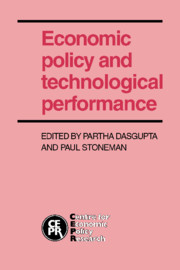Book contents
- Frontmatter
- Contents
- List of tables
- List of figures
- Preface
- List of participants
- Introduction
- 1 The economic theory of technology policy: an introduction
- 2 Current policy practice and problems from a UK perspective
- 3 The importance of technology policy
- 4 The value of patents as indicators of inventive activity
- 5 Learning to learn, localized learning and technological progress
- 6 Some analytical observations on diffusion policies
- 7 International trade and technology policy
- 8 Some new standards for the economics of standardization in the information age
- Index
1 - The economic theory of technology policy: an introduction
Published online by Cambridge University Press: 17 September 2009
- Frontmatter
- Contents
- List of tables
- List of figures
- Preface
- List of participants
- Introduction
- 1 The economic theory of technology policy: an introduction
- 2 Current policy practice and problems from a UK perspective
- 3 The importance of technology policy
- 4 The value of patents as indicators of inventive activity
- 5 Learning to learn, localized learning and technological progress
- 6 Some analytical observations on diffusion policies
- 7 International trade and technology policy
- 8 Some new standards for the economics of standardization in the information age
- Index
Summary
Introduction
An important channel through which firms engage in non-price competition is research and development (R&D). R&D expenditure designed to locate new or improved products and to lower manufacturing costs of existing products influences the structure of the industry. At the same time, industrial structure is a determinant of the incentives that firms possess for engaging in such forms of non-price competition as R&D competition. This mutual relationship was a central theme in Schumpeter (1950), although his discussion was not in a form that is amenable to tests. It is somewhat paradoxical then that until recently the investigations Schumpeter's writings stimulated were for the most part empirical. Here, there have been two broad trends. One has been the case-study approach; the other, an analysis of interindustry data by way of regressions undertaken between variables such as the degree of concentration, the intensity of R&D activity, the number of patents issued, growth in demand for products, and so forth. Elsewhere (see Dasgupta 1986) I have attempted to summarize a number of empirical findings from the latter route and have presented simple theoretical constructs which can account for them.
These constructs, and indeed most of the theoretical investigations in recent years on the economics of technological change, have aimed at explanation, not design; they have addressed an aspect of what is often called ‘positive economics’. Theoretical economists working in the field of technological change have not in recent years demonstrated much passion for issues in public policy.
- Type
- Chapter
- Information
- Economic Policy and Technological Performance , pp. 7 - 23Publisher: Cambridge University PressPrint publication year: 1987
- 8
- Cited by



